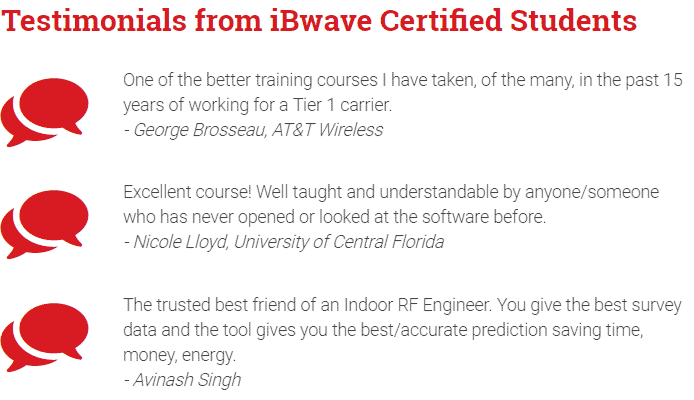Five Steps to Convince Your Boss To Get You iBwave Certified
Share

These days, there are resources and training materials on practically every subject you can imagine. It can be a daunting task finding training that’s both effective and relevant to your job. But without training, how can you be expected to stay up to date on the latest wireless trends and innovations? And once you do find the right course to enhance your skills, there’s the tall order of convincing your boss to pay for it.
So how exactly are you supposed to do that?
It’s not as intimidating a task as it might seem. We’ve compiled five tips to prepare yourself for pitching to your boss to approve your training. Follow these steps and you just might find yourself attending an award winning training program like iCP.
Step 1: Gather Information About Training Programs
It might seem like a no brainer, but many employees skip this step when pitching to their boss to ante up for training. Since there are so many courses online and in class, finding the right one is crucial to getting approval.
First, compare training programs you want to attend. Is one more expensive than the other? Does one offer more relevant topics to your industry? Is the training online, in person, or are both options available? Do they have a quiz you can take to see if the training offered is right for you? These are the first types of questions you should be asking when finding the right training program for your job.
Did you know iBwave has a world class, award winning training program? It’s true! The iBwave certification program (iCP) provides expert learning through three levels of courses on in-building wireless design with the software suite. With training packages offered in-person, online, or virtually, and a suite of different subjects to learn about, iCP is a proven program that caters to your specific needs. Best of all, iCP is BICSI certified, so you can be sure you’re getting quality training.
iBwave offers comprehensive details on their training program, including testimonials, pricing, and course information. This is where you should begin your journey.
Step 2: Compare Training Costs To ‘Lack of Knowledge’ Costs
Ok, you’ve found the training program you want to take. You have an idea of how much it’s going to cost and what level of training it will offer you. The next step is to compare this cost to the alternative – either in-house learning or nothing at all.
Does your lack of training on the subject cost your company money? Quite possibly. Lackluster teaching leads to drops in productivity and quality of work. And if you have a technical question outside of your realm of understanding, who are you supposed to turn to for support if no one is trained on the subject?
The bottom line: undertrained and undereducated employees cost a company money and reduce efficiency. Highlighting this point to your boss is crucial if you want to convince them to pay for your training program.
Step 3: Highlight Return on Investment for Your Company
Managers often tend to be big picture thinkers. Simply telling them that attending a training program will enhance your skills is probably not enough for them to sign off on it.
With that in mind, we suggest showcasing the high return on investment that paying for a training program offers.
It isn’t enough to tell them the training will benefit you. They need to see how it will benefit the company.
No sweat! We’ve gathered some of the most common benefits a company gets if its employees complete effective training:
- Designs and projects are finished faster.
- Training empowers employees to take ownership of their role in the office.
- Knowledge is contagious – trained employees can share their learning with others in the company
- Higher education leads to innovations and advancements in your workplace
The key here is to move the focus away from yourself and on to the company itself. The more you highlight the benefits of the big picture and less on your personal development, the more likely your boss will see why attending training is so crucial.
Step 4: Showcase the Trickle Down Effect
We touched on this on our last point, but the trickle-down effect really is a meaningful benefit to an employee getting training.
Employees who are trained on a subject can pass this knowledge on to others in their office that have not attended the training. This can take many forms, from informal conversations to structured presentations.
The net benefit is that the overall knowledge level of workers is increased, all while fostering a workplace culture centered around learning and development. You can even teach your boss the skills and insights you picked up while training.
Step 5: Demonstrate the Benefits of the Training
You know those before and after pictures of people on workout plans? Believe it or not, this tactic can also apply to convince your boss to pay for your training – both before and after you’ve completed it.
You won’t be showing your boss your new physique, but you will be able to compare the quality of work done before and after a training.
If you’ve yet to attend the training, show your boss some testimonials from the training program you want to take so they can understand the tangible benefits that it would provide.

Once you’ve completed a training, your pitch isn’t over! It’s important to show your boss how the training benefited your organization even after you’ve completed it. The best way to do this is to compare a project you worked on before the training to one after. Many training programs also offer official certification, which provides a global standard mandated by many tier 1 carriers. and professionalism that will reflect well on both yourself and your manager’s team.
There you have it! We hope we’ve demystified the process of convincing your boss to pay for your training. We’d also love to hear your tips on how to get your manager to approve a training program, so please share below!
What better way to begin your research on training programs than starting with one of the best?
- Wi-Fi 6: The Key Features - December 6, 2019
- LOL OMG BBQ?! – Understanding Wireless Industry Acronyms - November 27, 2019
- Feature Spotlight: Optimized Inclined Surface Modeling - November 6, 2019


























